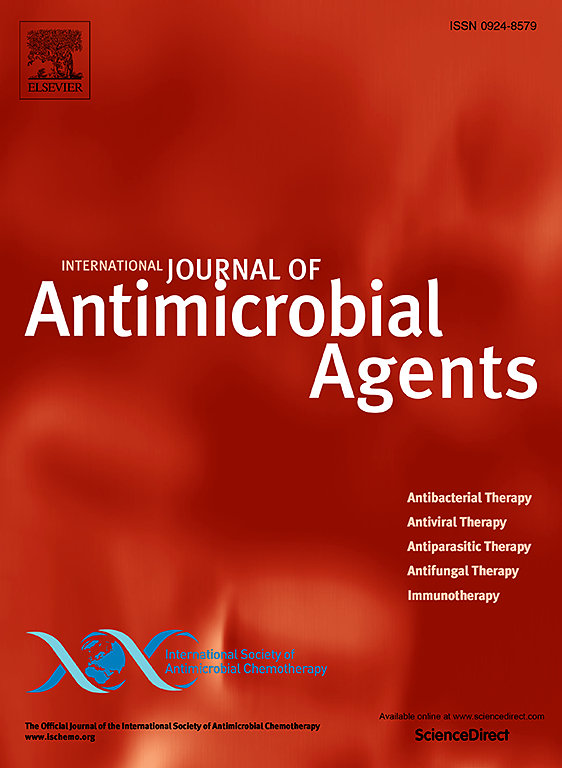Ceftazidime/avibactam resistance in Enterobacter cloacae due to the acquisition of a small pHAD28-like plasmid harbouring blaKPC-33
IF 4.6
2区 医学
Q1 INFECTIOUS DISEASES
International Journal of Antimicrobial Agents
Pub Date : 2025-05-16
DOI:10.1016/j.ijantimicag.2025.107540
引用次数: 0
Abstract
Objective
Ceftazidime/avibactam (CZA) is a β-lactam/β-lactamase inhibitor combination with potent activity against class A β-lactamases of Gram-negative bacilli. In recent years, its use and the emergence of CZA-resistant isolates have increased worldwide, including in Colombia. This study aimed to determine the resistome of a CZA-resistant Enterobacter cloacae isolate and a mobile genetic element related to the blaKPC-33 gene.
Methods
The isolate was recovered from a patient with a long hospital stay who had received initial CZA treatment for blaKPC-positive E. cloacae (CZA-susceptible) bacteraemia. Later, the patient suffered a urinary tract infection where a carbapenem- and CZA-resistant E. cloacae (ST456; ≥256/4 µg/mL) was isolated. The genome of 37Ecl06 was sequenced via NovaSeq (Illumina, San Diego, CA, USA.) and MinION (Oxford Nanopore Technologies, Oxford, UK), antibiotic resistance genes were determined with ResFinder and CARD, and mobile genetic elements identified with PlasmidFinder and ISFinder.
Results
Whole-genome sequencing revealed 10 resistance determinants in addition to blaKPC-33, which was mobilised within the conventional Tn4401b transposon, which in turn appeared to be transposed within a small pHAD28-like plasmid. pHAD28-backbone plasmids have mainly been identified in Salmonella spp. isolates recovered from humans, animals, and food.
Conclusion
This is the first report of an E. cloacae isolate harbouring blaKPC-33. These findings are relevant to continue to understand antimicrobial resistance dissemination mechanisms and to strengthen the One Health approach.
由于获得含有blaKPC-33的phad28样质粒,阴沟肠杆菌对头孢他啶/阿维巴坦的耐药性
目的:头孢他啶/阿维巴坦(CZA)是一种抗革兰氏阴性杆菌a类β-内酰胺酶的β-内酰胺/β-内酰胺酶联合抑制剂。近年来,它的使用和cza耐药分离株的出现在包括哥伦比亚在内的世界范围内有所增加。本研究旨在检测一株cza耐药阴沟肠杆菌分离株的抗性组和与blaKPC-33基因相关的可移动遗传元件。方法:从长期住院患者中分离出该分离株,该患者因blakpc阳性阴沟肠杆菌(CZA敏感)菌血症而接受CZA初始治疗。随后,患者发生尿路感染,分离出阴沟肠杆菌(ST456)碳青霉烯和cza耐药(≥256/4 ug/mL)。采用NovaSeq (Illumina)和MinION (Oxford NanoporeTechnologies)对37Ecl06进行基因组测序,采用ResFinder和CARD检测耐药基因,采用PlasmidFinder和ISFinder检测可移动遗传元件。结果:全基因组测序(WGS)显示,除了blaKPC-33外,还有10个耐药决定因素,该基因被动员到传统的Tn4401b转座子中,而Tn4401b转座子又被转移到一个小的phad28样质粒中。phad28骨架质粒主要存在于从人、动物和食物中分离出来的沙门氏菌中。结论:首次报道了一株携带blaKPC-33的阴沟肠杆菌分离株。这些发现对继续了解抗菌素耐药性传播机制和加强“一个健康”方针具有重要意义。
本文章由计算机程序翻译,如有差异,请以英文原文为准。
求助全文
约1分钟内获得全文
求助全文
来源期刊
CiteScore
21.60
自引率
0.90%
发文量
176
审稿时长
36 days
期刊介绍:
The International Journal of Antimicrobial Agents is a peer-reviewed publication offering comprehensive and current reference information on the physical, pharmacological, in vitro, and clinical properties of individual antimicrobial agents, covering antiviral, antiparasitic, antibacterial, and antifungal agents. The journal not only communicates new trends and developments through authoritative review articles but also addresses the critical issue of antimicrobial resistance, both in hospital and community settings. Published content includes solicited reviews by leading experts and high-quality original research papers in the specified fields.

 求助内容:
求助内容: 应助结果提醒方式:
应助结果提醒方式:


